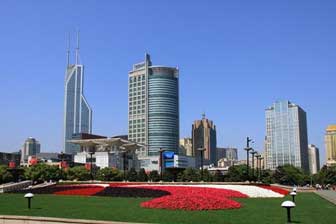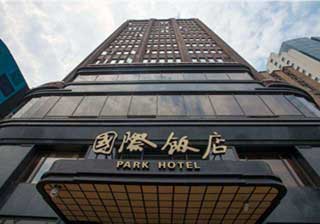- 86-15907880780
- contact@youngchinatravel.com
People's Square occupies the most central space in Shanghai. Here you will find a continuous  stream of people coming and going from when the sun comes up in the morning to when the sky darkens in the evening. They are off to visit the Shanghai Museum, listen to an evening of opera at the Shanghai Opera house, or shop at one of Shanghai's hundreds of shopping centers. In this square of velvet grass and luxuriant flowers, everyone is on the move, thousands of people heading to thousands of different destinations.
stream of people coming and going from when the sun comes up in the morning to when the sky darkens in the evening. They are off to visit the Shanghai Museum, listen to an evening of opera at the Shanghai Opera house, or shop at one of Shanghai's hundreds of shopping centers. In this square of velvet grass and luxuriant flowers, everyone is on the move, thousands of people heading to thousands of different destinations.
People's Square and the People's Park have a combined area of 140 thousand square meters, including 320 square meters of circular fountains and 80,000 square meters of green space.
Before liberation, the People's Square was ironically the location of the famous (or infamous) horse track. In 1861, director of the Shanghai horse racing society colluded with the British Consul to demand a piece of land from the Shanghai magistrate for horse racing. 31.1 hectares of land were conscripted at the lowest possible price, forcing countless numbers of farmers off their land, and building what was claimed to be the premier racing hall of the Far East.
All traces of the horse track have long since disappeared, and a new crop of structures have sprung up to take its place, beginning with the City Government Building, the new section of the Shanghai Museum, the Shanghai Grand Theater, Shanghai Art Museum, the underground mall, and Asia's largest underground electronic transformer substation. Naturally these structures have breathed new life and vitality into the Peoples' Square.
Centered on the themes of city, people, environment, and development, this exhibition uses hightech displays give you an understanding of Shanghai's huge postliberation achievements in construction. It also provides a grand blueprint of Shanghai's century spanning development, giving you an introduction to the great destinations of the past, present, and future. The center's basement level has a 500th scale recreation of 1930's Huaihai Road. Though not large in size, the model still includes such details as trolley cars, rickshaws, and old stores.
Established in 1956, this grand hall is dripping with artistic ambiance. Once known as 325 Nanjing Xilu's Kangle Restaurant, Shanghai Mayor Chen Yi hosted the dedication and ribbon cutting ceremony when this building was converted into the Shanghai Art Museum. Eventually the museum's collections outgrew the museum's size and facilities, and it was rebuilt in 1986 at its original Nanjing Xilu location. The new museum preserved and expanded upon the original structure of this 1930's English style building, keeping its red brick and iron railing. Not counting the old clock tower, the art museum's main building is four stories and 21 meters tall, and still retains a portion of its old basement level. Today, the museum's collections include over 4,000 pieces, and they are definitely worth exploring. With frequent activities and visiting exhibitions, there is also a nice variety of things to see in addition to the main collections. The Shanghai Biannual Art Expo is held at the Shanghai Art Museum every two years.
The Shanghai Theater Art Gallery sits right next to the art museum. The Gallery holds frequent exhibitions, and many of the original works on display are for sale. If you have time, stop in for a look.

During the fifty year span from the 1930's to the 1980's, the Park Hotel was one of Shanghai most identifiable buildings. The hotel's origins trace back to a four bank savings society established in 1923 by Dalu Bank, Yanye Bank, Jincheng Bank, and Zhongnan Bank. The savings group attracted over five million Yuan in investment to build an imposing building near Huanghe Lu. Originally meant to be called "The Twenty two Floor Shanghai Four Banks Savings Building", during preparations for the building's construction, one of the saving's society's charter members, Wu Dinghang, was told that he would make more money if he built not an office building, but a luxury hotel. Wu took the advice to heart and decided to build the Park Hotel instead. Daguangming Movie Theater designer, Laszlo Hudec, was hired to design the building, and construction of the building's foundation started in May 1931. The result was a study of American skyscraper architecture, utilizing its three dimensional feel to great effect. The Park Hotel quickly became a popular destination for Chinese and international military officers, political VIPs, and celebrities.
The Park Hotel's significance is not limited to banking history and famous hotel guests; the building also played an important role in surveying Shanghai's geography. In November 1950, the Shanghai government's land administration bureau used the Park Hotel's flag pole as a zero center point for the first official survey of Shanghai's geography and in the establishment of Shanghai's first plane coordination system. During the Hotel's remodeling in October 1997, this fact was commemorated with placard in the hotel lobby directly under the flagpole with the designation "Shanghai's Zero Center Point" To learn more about the Park Hotel please visit their web page at: www. parkhotel. com.cn
The People's Square is located in the center of Shanghai, and connects to Nanjing Lu's promenade and the western part of Xizang Zhonglu. Transportation to and from here is extremely convenient. By Subway: Take subway lines one or two and get off at the People's Square Station. By Bus: You can reach Peoples' Square on the following lines: 123,503,925,925B, 952,952B, 112, 46, 916, the Tunnel Number Six Line, 574, 581, 201, 203, 531,145,934, the Tunnel Number Three Line, and Tourist Line Number Ten.
Be sure to get off at Xizang Zhonglu; you can also take bus lines 71,127,202,775,789, 831, 935, 936, and the Tunnel Number four and five lines to Yan'an Lu; or take lines 23 or 109 and get off at Huangpi Beilu; if you take lines 17 or 864, get off at the Fuzhou Lu stop.
The following three attractions include museum like exhibitions. The Shanghai Museum and the Shanghai Art Museum have year round exhibits and are especially worth visiting during special exhibitions. If you want to see Mu En Church, the best plan of action is to visit over the weekend. Mu En Church does not frequently open on weekdays.
If you are looking for something to eat, you will not find a lot of choices on the Peoples' Square proper, but if you are willing to explore the immediate surrounding area you should be able to find something. Your best bet for finding a decent restaurant is probably along Fuzhou Lu and Nanjing Lu's promenade.
Maxims
Located on the Shanghai Grand Theater's eighth floor banquet hall, this restaurant serves decent French cuisine, but its main attraction is probably the incredible panoramic view of the People's Square off of the restaurant's terrace.
If you need a fix of mainstream caffeine, there is a Starbucks coffee house located diagonally across from the theater. It is a nice place to kick back with a cup of coffee and let your mind wander as you watch the late afternoon sun slowly droop toward the horizon.
Huanghe Road's Food Street
Huanghe Lu's Food Street is no longer as popular as it was in its heyday, but it is still worth a visit at nightfall when the street is ablaze with lights. It does not matter if you are looking for Shanghai, Sichuan, or Cantonese Cuisine; you can find it all here for reasonable prices. There are a few western restaurants at the head of the street, the most noticeable of which is the Taco Bell Mexican Restaurant.
The restaurants along Huanghe Lu will not blow you away with their unimposing store fronts, but their many charms become apparent when you step inside. Most eateries here are built in multiple storied buildings, so if the bottom floor of your favorite establishment seems full, than you can always check for an open table on the second or third floor. One thing to look out for is the particularly annoying restaurant solicitors along the road. Usually young males, these hawkers tend to camp out near the Taisheng Yuan Restaurant at the top of the street. When pedestrians pass by, the men will dart in, one from the right and one from the left, and try to convince you to come over to their places of business. If you are wandering through the area without a set destination, this can be a somewhat disorienting experience.
Chicken Hotpot (84 Huanghe Lu)
People come to this restaurant for their signature Jigongbao Chicken -Cooked in a chaffing dish, you stew bits of chicken and vegetables yourself as you would with any hot pot. This is a place where you can get great value for your money.
Bandao Restaurant (95 Huanghe Lu)
Bandao Jiulou is the busiest place on Huanghe Lu, and it’s easy to see why. This restaurant serves great local dishes at great prices. Some interesting entrees to try include the drunken shrimp, garlic ribs, crabs, and the cilantro with shredded snail meat.
Taisheng Yuan Restaurant (50 Huanghe Lu)
This traditionally runs restaurant serves local Shanghai fare. We suggest you try the steamed scallops in butter; and the beef ribs with black pepper.
Xiaonanguo Restaurant
Located between214-216 Huanghe Road, Xiaonanguo is a chain restaurant found all over Shanghai. The original restaurant is located here on Huanghe Roda. Xiaonanguo serves authentic local cuisine. Try the crabmeat tofu, drunken chicken, and crabs. Prices here tend to run a bit high. Expect to pay 100 RMB per person.
Jiajia Tangbao
This is a restaurant of the people that will never go out of style. Every night you can see a classic scene play itself out as card-playing customers lounge around waiting for their number to be called. The tangbao here come in with three different fillings, shrimp, pork and crab. We recommend you go for all three. Expect to fill up on about 10 RMB per person.